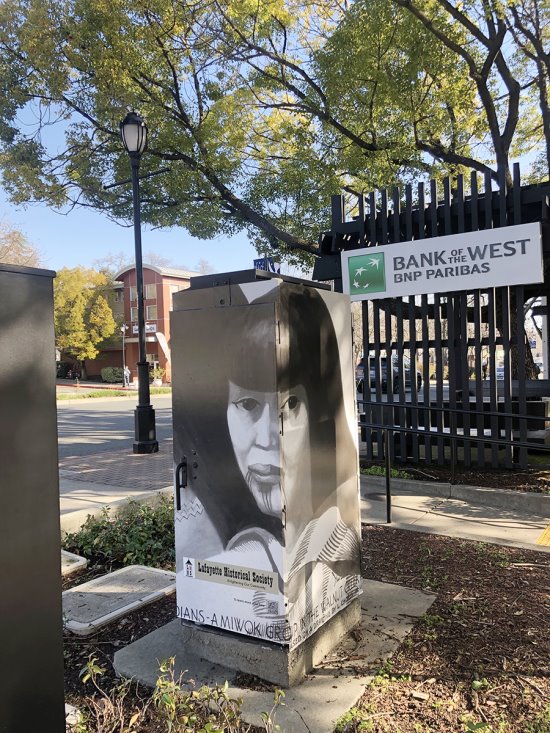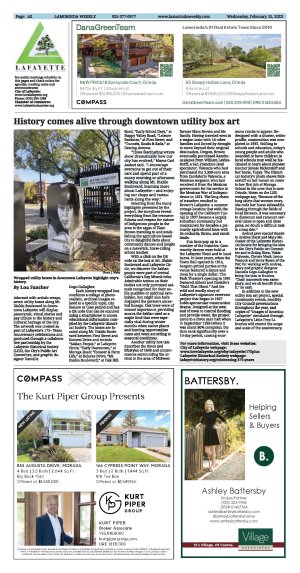|
|
Published February 15th, 2023
|
History comes alive through downtown utility box art
|
|
| By Lou Fancher |
 |
| Wrapped utility boxes in downtown Lafayette highlight city's history. Photo J. Wake |
Adorned with artistic wraps, seven utility boxes along Mt. Diablo Boulevard in downtown Lafayette will display panoramic, visual stories and pay tribute to the history and cultural heritage of the city. The artwork was created as part of Lafayette's 175+ Years Anniversary celebrations and produced through a collaborative partnership by the Lafayette Historical Society (LHS), the City's Public Art Committee, and graphic designer Danielle Gogo-Gallagher.
 Each history-wrapped box combines a collage of photo-realistic, archival images related to a specific topic, city feature or time period and has a QR code that can be scanned using a smartphone to access educational information compiled by the Lafayette Historical Society. The boxes are located along Mt. Diablo Boulevard between First Street and Dolores Drive and include "Saklan People," at Lafayette Circle; "Early Downtown," at Moraga Road; "Pioneer & Farm Life," at Dolores Drive; "Mt. Diablo Boulevard," at Oak Hill Road; "Early School Days," at Happy Valley Road; "Leisure Pastimes," at First Street; and "Tunnels, Roads & Rails," at Dewing Avenue.
Each history-wrapped box combines a collage of photo-realistic, archival images related to a specific topic, city feature or time period and has a QR code that can be scanned using a smartphone to access educational information compiled by the Lafayette Historical Society. The boxes are located along Mt. Diablo Boulevard between First Street and Dolores Drive and include "Saklan People," at Lafayette Circle; "Early Downtown," at Moraga Road; "Pioneer & Farm Life," at Dolores Drive; "Mt. Diablo Boulevard," at Oak Hill Road; "Early School Days," at Happy Valley Road; "Leisure Pastimes," at First Street; and "Tunnels, Roads & Rails," at Dewing Avenue.
 "These fascinating wraps show dramatically how our city has evolved," Mayor Carl Anduri said. "I encourage everyone to get out of their cars and spend part of a sunny morning or afternoon walking along Mt. Diablo Boulevard, learning more about Lafayette -- and enjoying our shops and restaurants along the way."
"These fascinating wraps show dramatically how our city has evolved," Mayor Carl Anduri said. "I encourage everyone to get out of their cars and spend part of a sunny morning or afternoon walking along Mt. Diablo Boulevard, learning more about Lafayette -- and enjoying our shops and restaurants along the way."
 Selecting from the many highlights presented by the project, the storylines reveal everything from the resourcefulness and respect for nature of Indigenous people in the area to the sagas of Elam Brown traveling to and establishing the agriculture-based city to delightful facts about community dances and insight on a maverick, horse-riding school teacher.
Selecting from the many highlights presented by the project, the storylines reveal everything from the resourcefulness and respect for nature of Indigenous people in the area to the sagas of Elam Brown traveling to and establishing the agriculture-based city to delightful facts about community dances and insight on a maverick, horse-riding school teacher.
 With a click on the QR code on the box at Mt. Diablo Boulevard and Lafayette Circle, we discover the Saklan people were part of central California's Bay Miwok tribe. Admirable tattoos on their bodies not only portrayed animals recognized for their noble qualities or spiritual symbolism, but might also have displayed the person's ancestral lineage. Oak trees were of utmost importance, providing acorns the Saklan used as a staple food that were especially vital during winter months when native plants and hunting opportunities came and went according to seasonal conditions.
With a click on the QR code on the box at Mt. Diablo Boulevard and Lafayette Circle, we discover the Saklan people were part of central California's Bay Miwok tribe. Admirable tattoos on their bodies not only portrayed animals recognized for their noble qualities or spiritual symbolism, but might also have displayed the person's ancestral lineage. Oak trees were of utmost importance, providing acorns the Saklan used as a staple food that were especially vital during winter months when native plants and hunting opportunities came and went according to seasonal conditions.
 Another utility box tale describes the times and lifestyles of 1848 and circumstances surrounding the arrival in the area of Midwest farmer Elam Brown and his family. Having traveled west in a wagon train with 14 other families and forced by drought to move beyond their original destination, Oregon, Brown eventually purchased Rancho Acalanes from William Leidesdorff, a San Francisco land speculator. Valencia who had purchased the 3,300-acre area from Candalerio Valencia, a Mexican sergeant, who had received it from the Mexican government for his service in the Mexican War of Independence in 1821. The long chain of transfers resulted in Brown's Lafayette: a summer cottage location that with the opening of the Caldecott Tunnel in 1937 became a largely suburban community but maintained for decades a primarily agricultural base with its orchards, farms, and ranch lands.
Another utility box tale describes the times and lifestyles of 1848 and circumstances surrounding the arrival in the area of Midwest farmer Elam Brown and his family. Having traveled west in a wagon train with 14 other families and forced by drought to move beyond their original destination, Oregon, Brown eventually purchased Rancho Acalanes from William Leidesdorff, a San Francisco land speculator. Valencia who had purchased the 3,300-acre area from Candalerio Valencia, a Mexican sergeant, who had received it from the Mexican government for his service in the Mexican War of Independence in 1821. The long chain of transfers resulted in Brown's Lafayette: a summer cottage location that with the opening of the Caldecott Tunnel in 1937 became a largely suburban community but maintained for decades a primarily agricultural base with its orchards, farms, and ranch lands.
 Fun facts pop up in a number of the histories: Community dances were held at the Lafayette Hotel and in local barns. In later years, when the Town Hall opened in 1914, bargain-priced parties at the venue featured a dance and meal for a single dollar. The Park Theatre's opening in 1941 featured Abbott and Costello's "Hold That Ghost." And the wild and woolly story of Lafayette's signature reservoir project that began in 1927 holds spectacular construction drama. Designed at the west end of town to control flooding and provide water, the project came to a three year halt when in September 1928 (when it was about 80% complete), the dam sank significantly over a 10-day period, causing enormous cracks to appear. Redesigned with a shorter, wider profile, construction was completed in 1933. Shifting to schools and education, today's young people and adults who attended or have children in local schools may well be fascinated to learn about pioneer teacher Jennie Bickerstaff and her horse, Topsy. The Historical Society's photo shows Bickerstaff on her mount en route to her first job at Moraga School in the area that is now Orinda. Notes on the LHS webpage say, "Because of the long skirts that women wore, she rode her horse sidesaddle. Passing through the fields of local farmers, it was necessary to dismount and remount several times to open and close gates, no doubt a difficult task in a long skirt."
Fun facts pop up in a number of the histories: Community dances were held at the Lafayette Hotel and in local barns. In later years, when the Town Hall opened in 1914, bargain-priced parties at the venue featured a dance and meal for a single dollar. The Park Theatre's opening in 1941 featured Abbott and Costello's "Hold That Ghost." And the wild and woolly story of Lafayette's signature reservoir project that began in 1927 holds spectacular construction drama. Designed at the west end of town to control flooding and provide water, the project came to a three year halt when in September 1928 (when it was about 80% complete), the dam sank significantly over a 10-day period, causing enormous cracks to appear. Redesigned with a shorter, wider profile, construction was completed in 1933. Shifting to schools and education, today's young people and adults who attended or have children in local schools may well be fascinated to learn about pioneer teacher Jennie Bickerstaff and her horse, Topsy. The Historical Society's photo shows Bickerstaff on her mount en route to her first job at Moraga School in the area that is now Orinda. Notes on the LHS webpage say, "Because of the long skirts that women wore, she rode her horse sidesaddle. Passing through the fields of local farmers, it was necessary to dismount and remount several times to open and close gates, no doubt a difficult task in a long skirt."
 Anduri gave special thanks to Andree Hurst and Mary McCosker of the Lafayette Historical Society for bringing the idea to the City's Public Art Committee and to Erling Horn, Yukie Fujimoto, Christy Mack, Janice Peacock and Jenny Rosen of the PAC for working with Andree, Mary and graphic designer Danielle Gogo-Gallagher to bring the idea to fruition.
Anduri gave special thanks to Andree Hurst and Mary McCosker of the Lafayette Historical Society for bringing the idea to the City's Public Art Committee and to Erling Horn, Yukie Fujimoto, Christy Mack, Janice Peacock and Jenny Rosen of the PAC for working with Andree, Mary and graphic designer Danielle Gogo-Gallagher to bring the idea to fruition.
 "Their teamwork was exemplary, and we all benefit from it," he said.
"Their teamwork was exemplary, and we all benefit from it," he said.
 In addition to the new utility box art project, special community events, monthly City Council presentations throughout the year, and copies of "Images of America: Lafayette" circulated through Lafayette's Little Free Libraries will extend the scope and scale of the anniversary.
In addition to the new utility box art project, special community events, monthly City Council presentations throughout the year, and copies of "Images of America: Lafayette" circulated through Lafayette's Little Free Libraries will extend the scope and scale of the anniversary.
 For more information, visit these websites:
For more information, visit these websites:
 City of Lafayette webpage:
www.lovelafayette.org/why-lafayette/175plus
City of Lafayette webpage:
www.lovelafayette.org/why-lafayette/175plus
 Lafayette Historical Society webpage:
www.lafayettehistory.org/celebrating-175-years
Lafayette Historical Society webpage:
www.lafayettehistory.org/celebrating-175-years |
|
|
|
|
|
|
|
|
|
|
|
|
|



